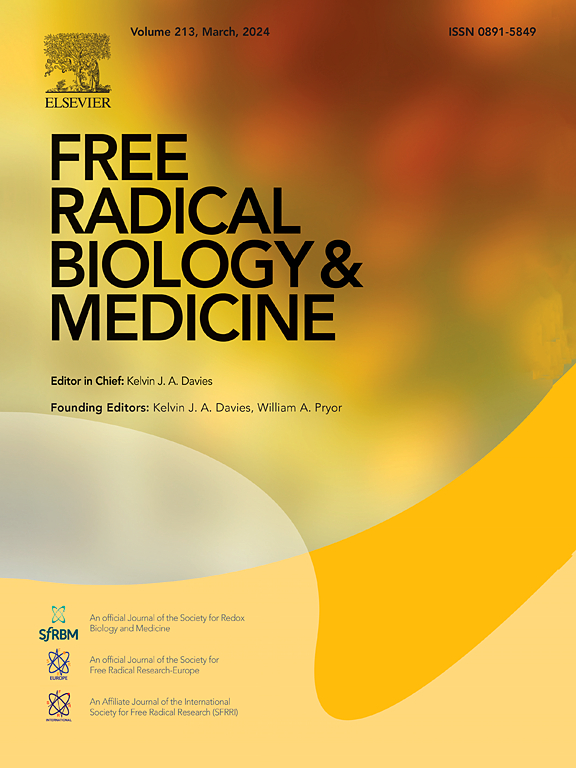Inhibition of JNK signaling attenuates photoreceptor ferroptosis caused by all-trans-retinal
IF 7.1
2区 生物学
Q1 BIOCHEMISTRY & MOLECULAR BIOLOGY
引用次数: 0
Abstract
The disruption of the visual cycle leads to the accumulation of all-trans-retinal (atRAL) in the retina, a hallmark of autosomal recessive Stargardt disease (STGD1) and dry age-related macular degeneration (AMD), both of which cause retinal degeneration. Although our previous studies have shown that atRAL induces ferroptosis and activates c-Jun N-terminal kinase (JNK) signaling in the retina, the relationship between JNK signaling and ferroptosis in atRAL-mediated photoreceptor damage remains unclear. Here, we reported that JNK activation by atRAL drove photoreceptor ferroptosis through ferritinophagy. In photoreceptor cells loaded with atRAL, activated JNK phosphorylated c-Jun, which facilitated its nuclear translocation and promoted the expression of the nuclear receptor coactivator 4 (NCOA4). Elevated NCOA4 induced ferritin degradation via lysosomal processing, a process known as ferritinophagy, thereby releasing a large amount of labile iron. Iron overload led to the generation of reactive oxygen species (ROS) and lipid peroxidation, ultimately culminating in ferroptosis. Treatment with the JNK inhibitor JNK-IN-8, as well as the knockout of Jnk1 and Jnk2 genes, significantly rescued atRAL-loaded photoreceptor cells from ferritinophagy-induced ferroptosis. Abca4−/−Rdh8−/− mice, which exhibit atRAL accumulation in the retina following light exposure, are commonly used to study the pathological processes of STGD1 and dry AMD. In these mice, light exposure activated the JNK/c-Jun/NCOA4 axis, resulting in ferritinophagy in the neural retina. Importantly, intraperitoneal administration of JNK-IN-8 significantly rescued retinal function and photoreceptors from ferritinophagy-induced ferroptosis and effectively mitigated retinal degeneration in light-exposed Abca4−/−Rdh8−/− mice. This study underscores the critical role of the JNK/c-Jun/NCOA4 axis in mediating atRAL-induced ferritinophagy, which drives ferroptosis and retinal atrophy, suggesting that targeting this pathway may offer a potential therapeutic approach for STGD1 and dry AMD.

JNK信号的抑制可减弱全反式视网膜引起的光感受器铁下垂。
视觉周期的中断导致视网膜中全反式视网膜(atRAL)的积累,这是常染色体隐性Stargardt病(STGD1)和干性年龄相关性黄斑变性(AMD)的标志,两者都会导致视网膜变性。虽然我们之前的研究表明,atRAL诱导铁下垂并激活视网膜中的c-Jun n -末端激酶(JNK)信号,但在atRAL介导的光感受器损伤中,JNK信号传导与铁下垂之间的关系尚不清楚。在这里,我们报道了atRAL激活JNK通过铁蛋白自噬驱动光感受器铁下垂。在负载atRAL的光感受器细胞中,活化的JNK使c-Jun磷酸化,促进其核易位并促进核受体共激活因子4 (NCOA4)的表达。升高的NCOA4通过溶酶体加工诱导铁蛋白降解,这一过程被称为铁蛋白自噬,从而释放大量不稳定的铁。铁超载导致活性氧(ROS)的产生和脂质过氧化,最终导致铁下垂。用JNK抑制剂JNK- in -8治疗,以及敲除Jnk1和Jnk2基因,可显著拯救atral负载的光感受器细胞,使其免于铁蛋白吞噬诱导的铁下垂。Abca4-/- rdh8 -/-小鼠在光照射后视网膜中表现出atRAL积累,通常用于研究STGD1和干性AMD的病理过程。在这些小鼠中,光照激活了JNK/c-Jun/NCOA4轴,导致神经视网膜的铁蛋白吞噬。重要的是,在光暴露的Abca4-/- rdh8 -/-小鼠中,腹腔给药JNK-IN-8可显著拯救由食铁蛋白诱导的铁下垂的视网膜功能和光感受器,并有效减轻视网膜变性。这项研究强调了JNK/c-Jun/NCOA4轴在介导atral诱导的铁蛋白噬噬中所起的关键作用,铁蛋白噬噬可驱动铁ptosis和视网膜萎缩,这表明靶向该途径可能为STGD1和干性AMD提供潜在的治疗方法。
本文章由计算机程序翻译,如有差异,请以英文原文为准。
求助全文
约1分钟内获得全文
求助全文
来源期刊

Free Radical Biology and Medicine
医学-内分泌学与代谢
CiteScore
14.00
自引率
4.10%
发文量
850
审稿时长
22 days
期刊介绍:
Free Radical Biology and Medicine is a leading journal in the field of redox biology, which is the study of the role of reactive oxygen species (ROS) and other oxidizing agents in biological systems. The journal serves as a premier forum for publishing innovative and groundbreaking research that explores the redox biology of health and disease, covering a wide range of topics and disciplines. Free Radical Biology and Medicine also commissions Special Issues that highlight recent advances in both basic and clinical research, with a particular emphasis on the mechanisms underlying altered metabolism and redox signaling. These Special Issues aim to provide a focused platform for the latest research in the field, fostering collaboration and knowledge exchange among researchers and clinicians.
 求助内容:
求助内容: 应助结果提醒方式:
应助结果提醒方式:


